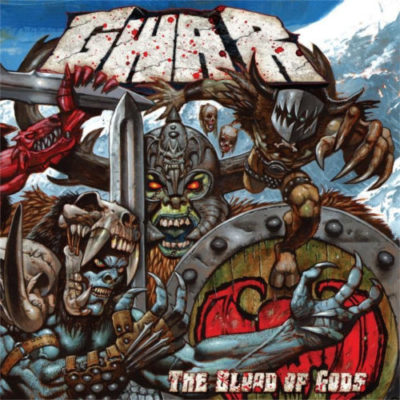Producing Gwar had been on my bucket list for a long time. This year I got the chance to produce, recording, mix and master their new album. My desire to work with Gwar was not because they are a iconic shock rock band, but because underneath all the costumes and shock value, they are fantastic musicians. I really wanted to make an album that showcased how cool they are as players.
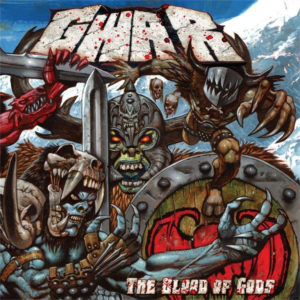 A lot of hard rock and metal production of the last decade or so seems to be all about making albums that are ultra processed, standardized and sanitized to an extent that you do not really hear the personality of the musicians. With a lot of those albums, just like hearing a new song from Britney Spears or Ariana Grande, I almost hear the producers and the Pro Tools editors more than the actual artists. I had no interest in making that kind of album with Gwar. I wanted to make an album that people would listen to, and hear the power and personality of the players, rather than my Pro Tools chops. When Gwar’s new album, “The Blood of Gods” (Metal Blade) is released October 20th, I hope that is what people hear.
A lot of hard rock and metal production of the last decade or so seems to be all about making albums that are ultra processed, standardized and sanitized to an extent that you do not really hear the personality of the musicians. With a lot of those albums, just like hearing a new song from Britney Spears or Ariana Grande, I almost hear the producers and the Pro Tools editors more than the actual artists. I had no interest in making that kind of album with Gwar. I wanted to make an album that people would listen to, and hear the power and personality of the players, rather than my Pro Tools chops. When Gwar’s new album, “The Blood of Gods” (Metal Blade) is released October 20th, I hope that is what people hear.
To make that album, I relied on a somewhat classic approach to making the album. I did not want the drums to sound like a synthetic drum machine. Brad Roberts (Jizmak da Gusha) has such amazing feel as a player, that I wanted it to feel like you were sitting in front of his drum set getting your ass kicked by his playing. There are some parts on the album where samples were used to bring clarity, but most of what you hear is the sound of a great drummer as he played it, recorded in a cool room through great gear. We did not quantize a single drum hit on the entire album (or a single note of the guitars). I wanted the album to feel like sitting in front of Gwar performing at the top of their game.
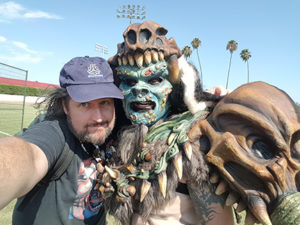 Another reason for going for a more natural drum sound was that I wanted the feel of the guitarists’ playing to come through. It can be fun to have giant fake drums where every kick drum hit takes your head off, but those giant fake drums usually obscure a lot of details of the guitars. Mike Derks (Balsac the Jaws of Death) and Brent Purgason (Pustulus Maximus) are great players with distinct feels. We worked really hard to come up with cool parts and to get the best possible performances and I needed to make sure the fans felt the detail of every riff in their gut.
Another reason for going for a more natural drum sound was that I wanted the feel of the guitarists’ playing to come through. It can be fun to have giant fake drums where every kick drum hit takes your head off, but those giant fake drums usually obscure a lot of details of the guitars. Mike Derks (Balsac the Jaws of Death) and Brent Purgason (Pustulus Maximus) are great players with distinct feels. We worked really hard to come up with cool parts and to get the best possible performances and I needed to make sure the fans felt the detail of every riff in their gut.
My solution was to take a minimal approach to the guitars. Most parts on the album have only two guitars, panned hard left and right. It is usually one guy on each side, but in a few spots where we thought one player’s feel better suited a certain riff, we would have one guy play both parts (sometimes on a riff the other guitarist wrote). We did layer some parts for special effects, but most of the time on this kind of album I want as few guitars as possible, because the more you layer the guitars the more you smooth off the edges of the performance. This can obscure some of the detail of the player’s style, but also soften the punch and “in your face-ness” of the guitars. The quest for punch and detail also dictated how I approached recording the guitars.
About 5% of the guitars were recorded through a Fractal Audio Axe-FX. Derks had created unique special effects for certain songs that were reliant on the Axe-FX. Every other guitar on the album was recorded with a single Shure SM57 on a Marshall 4×12 cabinet.
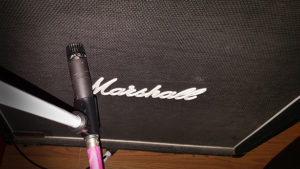 I am a big fan of using a single mic on guitar cabinets. The reason for this is that a single mic is the absolute best-case scenario for solid phase. Solid phase equals power, punch and detail. When using multiple mics, no matter how much you adjust the phase relationship between the various mics, you will always have some degree of phase distortion, which can smear impact and detail on the guitars. When recording, I will almost never use two mics when I can do a great job with one.
I am a big fan of using a single mic on guitar cabinets. The reason for this is that a single mic is the absolute best-case scenario for solid phase. Solid phase equals power, punch and detail. When using multiple mics, no matter how much you adjust the phase relationship between the various mics, you will always have some degree of phase distortion, which can smear impact and detail on the guitars. When recording, I will almost never use two mics when I can do a great job with one.
There are a lot of great mics for recording electric guitars, and I will use whatever sounds best, but I usually end up with the Shure SM57. There is a reason it is the most popular guitar mic in the history of recorded music. The thing about the 57 is that it is very sensitive to mic placement, so you need to work to find the best spot on the speaker, and they sound much better run into a good pre-amp. Every guitar on “The Blood of Gods” was recorded with A-Designs Pacifica mic pres. After the mic pre, the guitars would sometimes get a little compression from a Pete’s Place 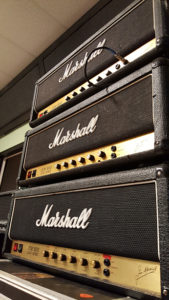 “BAC 500” compressor (somewhat similar to an 1176). Heavy guitars do not need much compression, since gain from the amp usually does creates a lot of natural compression. The guitars sometimes got a dB or two of sculpting EQ from either an Electrodyne “511” or an A Designs “EM-PEQ” (a solid state pultec style EQ). The EQ was mostly for mojo. I knew I would be mixing in a hybrid set up and wanted to get some analog transformer goodness on the way in to make the mixing a little easier.
“BAC 500” compressor (somewhat similar to an 1176). Heavy guitars do not need much compression, since gain from the amp usually does creates a lot of natural compression. The guitars sometimes got a dB or two of sculpting EQ from either an Electrodyne “511” or an A Designs “EM-PEQ” (a solid state pultec style EQ). The EQ was mostly for mojo. I knew I would be mixing in a hybrid set up and wanted to get some analog transformer goodness on the way in to make the mixing a little easier.
We recorded sections of a couple of songs with a Peavy 6505 head because they can be great for ultra high gain sounds, but the amp did not see a lot of action because ultra high gain is exactly what I did not want for this album. When I was working with the guitarists for the best tone for each song, we went for cleaner guitars than they had done on the last few albums. I did this because of my quest to get the guitars as big and “in your face” as possible. One of the things that a lot of guitarists and engineers do not realize is that, as much fun as it is to play with super high gain amps, the high gain smears the articulation and clarity of the guitar part. The result of this is that the guitars lose their presence and are naturally pushed back into the mix (i.e., less present). The other result is that you lose detail and clarity in the guitars. It makes it harder to hear the unique phrasing of the player and any harmonic nuance of the player’s chord voicings or pick technique. If you listen to many of the all-time great heavy guitar albums, you may be surprised at how clean the guitar sounds are. Classic AC/DC and Black Sabbath albums have very clean guitar sounds, for example
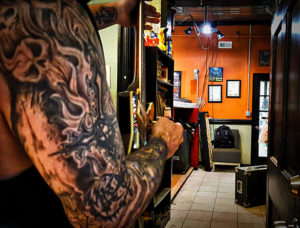 For most of the album we used a large collection of older Marshall JCM800 heads, with various power, transformer and tube combinations. Despite using different versions of the same kind of amp, we were able to get a wide range of tones on the album (which fit the wide range of playing styles on the album.) Some people will see an amp like the JMC800 and think that the limited controls would equal a limited range of tonal options, but, like all great tube amps, they are very responsive to what happens in front of the amp. Difference in guitar selection, pick up selection, guitar volume and pedal choice can have dramatic changes on the tone. We used humbucker pickups almost exclusively, employing several guitars from Schecter, Dean and Love Rock.
For most of the album we used a large collection of older Marshall JCM800 heads, with various power, transformer and tube combinations. Despite using different versions of the same kind of amp, we were able to get a wide range of tones on the album (which fit the wide range of playing styles on the album.) Some people will see an amp like the JMC800 and think that the limited controls would equal a limited range of tonal options, but, like all great tube amps, they are very responsive to what happens in front of the amp. Difference in guitar selection, pick up selection, guitar volume and pedal choice can have dramatic changes on the tone. We used humbucker pickups almost exclusively, employing several guitars from Schecter, Dean and Love Rock.
“The Blood of Gods” drops October 20th worldwide.
Ronan Chris Murphy
Ronan Chris Murphy – Producer/mixer/mastering – has diverse credits ranging from Prog-Rock legends King Crimson to YouTube sensation Tay Zonday to shock rockers GWAR and everything in between, including Tony Levin, Steve Morse, Terry Bozzio, Alexia, Martin Sexton, Ulver, Jamie Walters, Steve Stevens and Nels Cline. His productions have charted as far away as Iceland, Greece and Malaysia. He also works on music for non-album projects including the hit Norwegian film Uno and video games Mafia III and Assassin’s Creed Brotherhood. He is the founder of Recording Boot Camp, which helped pioneer the recording intensive concept and has launched an online training series.
